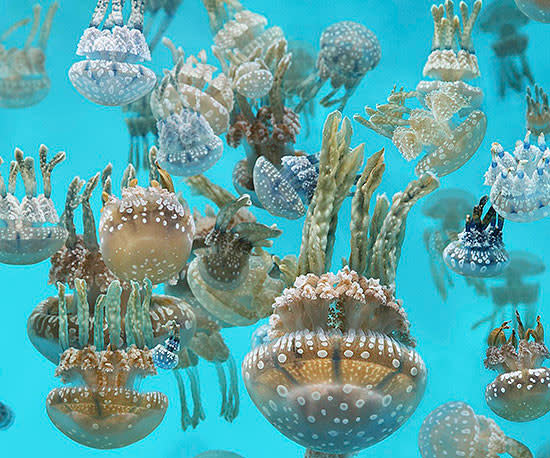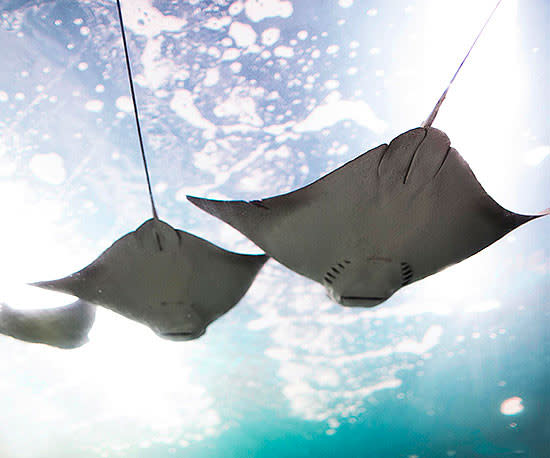Amazing New Zoo and Aquarium Exhibits

Forget watching caged critters from afar. These days, zoos and aquariums are bringing you into exhibits for in-your-face encounters and letting you touch and feed some of the exotic creatures in their care. Whether you're stroking a stingray in a touch tank or letting a giraffe nibble lettuce from your hand, getting that close can open your eyes and spark your imagination. With that in mind, here we offer a few of the coolest new animal (mammal, fish, fowl, and reptile) encounters, from an outdoor room where parakeets fly free to an mirrored gallery of otherworldly jellyfish. We think you'll love discovering what's new at the zoo -- and maybe you'll emerge feeling renewed yourself.
Lair (Living Amphibians, Invertebrates, and Reptiles)
Los Angeles Zoo and Botanical Gardens Los Angeles, California
You're staring into a mountain stream, catching a glimpse of the world's largest amphibian, the Chinese giant salamander, which can reach more than seven feet in length. Or maybe you're peering through the forest canopy at the reclusive bushmaster, at upwards of six feet, the longest venomous snake in the Americas. Or you're engulfed in the sights and sounds of a monsoon in the California desert (thanks to the immersive acoustics of AstoundSound), as scorpions and Gila monsters scurry for cover. You must be at LAIR, the Los Angeles Zoo's newest attraction, featuring some of the rarest species of amphibians, invertebrates, and reptiles. The two new and spectacular buildings?and their outdoor habitats?house 49 exhibits in six themed areas. In addition to viewing the animals in their element (from damp forests to croc-infested swamps), you can watch zookeepers preparing food, storing reptile eggs, and tending animal babies in the Behind the Glass exhibit. In the Care and Conservation Room, you'll learn about the zoo's efforts to save such rare and endangered species as the Gray's monitor lizard.

The Jellies Experience
Monterey bay aquarium Monterey, California
If your kids refuse to believe that the jellyfish in this eye-popping exhibit really belong to the animal kingdom, who can blame them? From Mediterranean jellies that look like iridescent floating crystals to colorful flower-hat jellies that could pass for weird outer space Easter bonnets, these pulsing, dancing, undulating creatures look like they sprang from the wild imagination of a master animator. The exhibit, which features 1960s-style psychedelic images and music, showcases 16 species from around the world, but it doesn't stop there. At the Light Show, you can gape at fluorescent, bioluminescent, and iridescent jellies and corals and trigger a light show of your own with a wave of your arm. In the Jellies Explosion gallery, mirrored walls reflect cylinders filled with moon jellies, making you feel as if you're swimming through a massive swarm. And if you're curious about how jellyfish sting and eat their prey, the gallery known as Delicate Danger will make it all too clear.
River Giants
Tennessee aquarium Chattanooga, Tennessee
There are fish and then there are...FISH. The latter variety -- the kind whose mind-boggling size and proportions make you gasp -- are exactly what you'll encounter in River Giants, the oversize exhibit that opened in April at the Tennessee Aquarium. Mounted in collaboration with the producers of National Geographic's TV show Monster Fish, the exhibit features a 90,000-gallon tank housing some of the world's biggest and strangest fresh-water creatures: 7-foot-long lake sturgeon, huge long-whiskered catfish, rays as big as dinner tables, and 100-pound arapaimas that look as if they just shimmied in from the Paleozoic Era. At the video kiosk, check out enormous water-dwellers tagged and documented by Monster Fish host Dr. Zeb Hogan.

The African Forest
Houston zoo Houston, Texas
Thanks to the Houston Zoo, it's now possible to visit Africa in the morning and be home in time for dinner. This new, 6.5-acre attraction starts at a re-created village outpost. From there, you can follow a winding trail through a series of "immersion" exhibits, in which the barriers between people and animals are virtually invisible. Tommy's Tree House, a rustic indoor room filled with interactive attractions, lets you get nose-to-nose with a colony of chimps through a large glass wall. At the giraffe habitat, you can hand out treats from a raised feeding platform. And farther along the way, you'll find niches with white rhinos, antelope, and other animals native to Western equatorial Africa.

Shark Gallery
Greater Cleveland Aquarium Cleveland, Ohio
Everything is new at this aquarium, which opened in January 2012. But you can't go wrong starting your visit with a stroll through the 500,000-gallon shark tank. And we do mean "through": a 145-foot transparent tunnel that traverses the tank lets you rub noses with a school of cownose rays and trade toothy grins with 7-foot sand tiger sharks, all without wetting a toe. If that's not close enough for you, divers at the aquarium's 11,000-gallon touch tank will happily retrieve a ray, a hermit crab, or a baby sand shark that you can (gently) touch. Housed in a converted power station, the aquarium boasts 35 tanks all told, containing thousands of animals. The exhibits take you from Ohio's lakes and rivers (home to channel catfish and red-eared slider turtles) to the Florida Keys, where you'll meet such deadly marine creatures as the aptly named lionfish and scorpion fish.

Parakeet Pointe
Audubon Aquarium of the Americas New Orleans, Louisiana
Step into Parakeet Pointe on the second floor of the Audubon Aquarium, and you'll find yourself in an enclosed outdoor aviary with a sweeping view of the Mississippi River. Yet that vista is likely to pale compared to what surrounds you: a lush semitropical environment where hundreds of parakeets, flashing like brightly colored jewels, swoop and soar in a rush of sound and movement. Because these are captive-bred birds, you'll observe a dazzling array of colorations and patterns not normally seen in the wild. And if you buy a feeding stick for a dollar, you're certain to garner yourself some fans among these intelligent and gregarious creatures. Don't be surprised if your new feathered friends decide to hang out on your shoulder for a while or across your outstretched arms.

